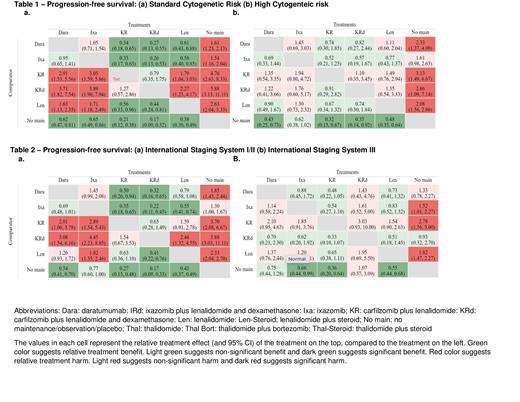Introduction
The optimal maintenance regimen by prognostic categories remains unclear in newly diagnosed multiple myeloma (NDMM) patients undergoing autologous stem cell transplant (ASCT). Therefore, we conducted a systematic review and network meta-analysis (NMA) to assess the comparative effectiveness of novel agents by different prognostic groups.
Methods
A comprehensive systematically structured literature search was conducted to identify phase II/III randomized controlled trials (RCTs) evaluating maintenance therapies in post-transplant NDMM patients and reporting data by subgroups including but not limited to international staging system (ISS), and cytogenetic risk. High cytogenetic risk (HCR) and standard cytogenetic risk (SCR) were defined in accordance with the eligible trials. Main outcomes of interest were overall survival (OS) and progression-free survival (PFS). Precomputed hazard ratios (HR) with 95% CI were pooled using an inverse variance approach. A frequentist network meta-analysis was conducted. P-score (PS) were used to assess relative rankings of the treatments and were interpreted in congruency with pairwise estimates. Higher ranks indicated better efficacy.
Results
This NMA included six RCTs with 4119 participants and six unique treatment arms. In patients with SCR, the combination of carfilzomib, lenalidomide, and dexamethasone (KRd) improved PFS when compared to lenalidomide (Len; HR: 0.44; 95% CI: 0.24-0.81), daratumumab (Dara; 0.27; 0.13-0.55), ixazomib (Ixa; 0.26; 0.13-0.53), and no maintenance therapy (0.17; 0.09-0.32). Similarly, KR improved PFS compared to lenalidomide (Len; 0.56; 0.33-0.96), daratumumab (Dara; 0.34; 0.18-0.65), ixazomib (Ixa; 0.33; 0.17-0.63), and no maintenance therapy (0.21; 0.12-0.38). There was no statistically significant difference between KRd and KR. KRd was ranked as potentially the most efficacious treatment (rank 1) followed by KR (rank 2), Len (rank 3), Dara (rank 4), and Ixa (rank 5) for improving PFS in SCR. In patients with HCR, KRd (0.35; 0.14-0.92), KR (0.32; 0.15-0.67), Dara (0.43; 0.25-0.73), and Len (0.48; 0.35-0.64) improved PFS when compared to no maintenance therapy. No other significant differences were observed in HCR patients. KR was ranked as potentially the most efficacious treatment followed by KRd (rank 2), Dara (rank 3), Len (rank 5), and Ixa (rank 5) for PFS in HCR patients. In patients with ISS-I/II, KRd and KR improved PFS when compared to Dara (KRd vs. Dara - 0.32; 0.16-0.65, KR vs Dara - 0.50; 0.26-0.94), and Ixa (KRd vs. Ixa - 0.22; 0.11-0.45, KR vs Ixa - 0.35; 0.18-0.65). KRd, not KR, improved PFS when compared to Len (0.41; 0.22-0.76). Rankings were consistent with those observed in SCR patients. No significant differences were observed among mixed treatment comparisons for ISS-III patients. Limited number of trials reporting OS precluded formal assessment.
Conclusions
The current data suggest that KRd and KR may delay disease progression regardless of risk category. Overall survival data is still emerging and, if consistent, may influence clinical practice. We maintain a living meta-analysis to incorporate new evidence constantly.
Disclosures
Chakraborty:Janssen: Consultancy, Honoraria; Sanofi: Consultancy, Honoraria; Adaptive Biotech: Consultancy, Honoraria; Genentech: Research Funding; AbbVie: Research Funding. Aljama:Janssen: Honoraria, Membership on an entity's Board of Directors or advisory committees; Pfizer, Sanofi and Beigene: Membership on an entity's Board of Directors or advisory committees.


